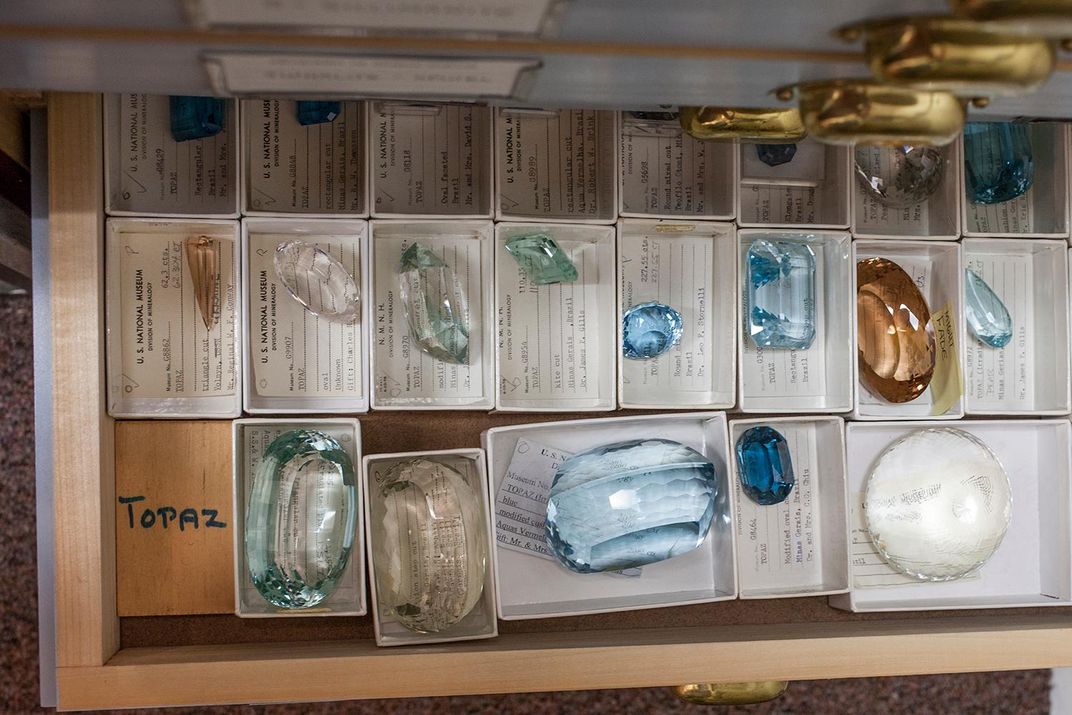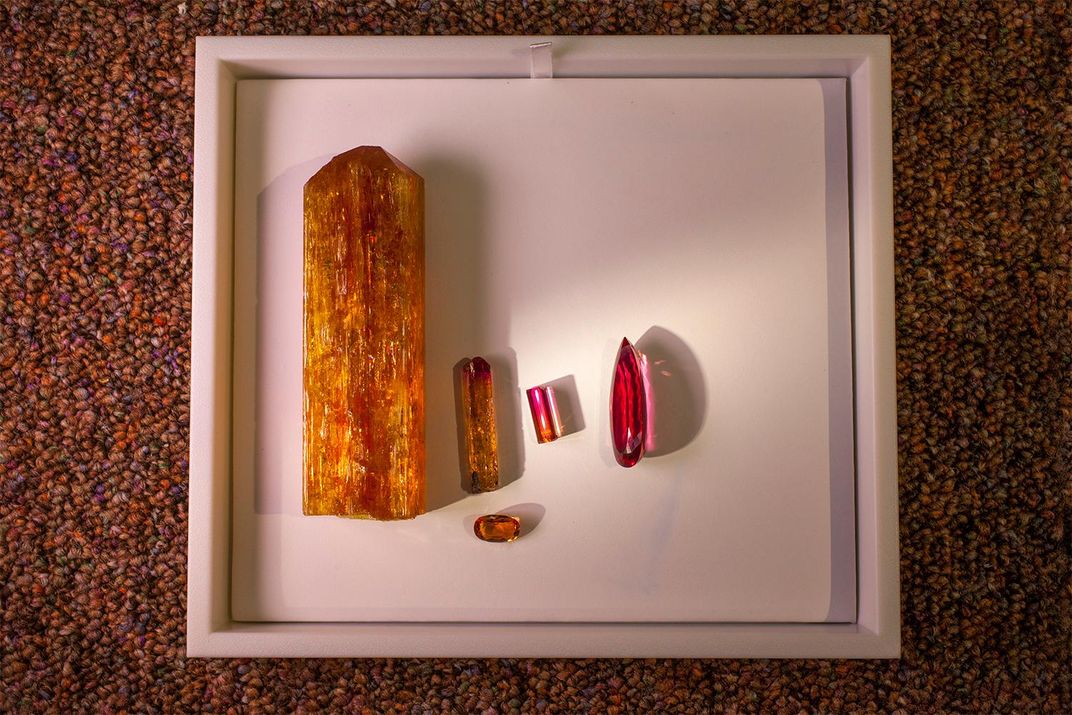The Whitney Flame Topaz Smolders in Vibrant Red
A new gemstone at the Natural History Museum is already igniting wonder in viewers
/https://tf-cmsv2-smithsonianmag-media.s3.amazonaws.com/filer/a2/b6/a2b6692c-b857-47cd-a853-bcc74845396b/topaz18.jpg)
A visit to the local jeweler’s and a request for topaz is likely to turn up an assortment of blue stones, ranging from near clear to cerulean. Mined transparent and subjected to color alteration via radiation in laboratories, these gems are inexpensive and ubiquitous—as Smithsonian minerals curator Jeffrey Post observes, you’re liable to spend more on the gold of the band in which the topaz is set than the stone itself.
But the gem that just this morning went on display at the Smithsonian’s Natural History museum, dubbed the “Whitney Flame” in honor of its donor, Coralyn Whitney, is a topaz of another color. As its name suggests, this topaz is shot through with rich, fiery red. Cut in the shape of an elegant teardrop, the Flame is a particularly pristine specimen culled from the mines of topaz mecca Ouro Preto, Brazil, and its debut at the Smithsonian promises to drum up renewed interest in topaz worldwide.
The reddish hue discernible in a number of Ouro Preto topazes is the result of atoms of the metal chromium making their way into the mineral's crystalline structure. “In addition to the basic components—aluminum, silicon, oxygen, fluorine—that make a topaz a topaz,” says Post, “you have a trace amount of chromium that happens to get incorporated.” Unlike the blue of mass-market topazes, the red of red topaz cannot be fabricated in a laboratory. If geological conditions at the source aren’t right, a topaz crystal will never be red.
The mining municipality of Ouro Preto has long been a source of topaz crystals, with relatively many bearing at least a hint of the prized rubicund glow. Yet even in this tropical topaz Golconda, seeking out marketable minerals is akin to playing the lottery. “Of all the topaz found in that locality,” says Post, “only about a percent or two is gem quality. And of those one to two percent, maybe one percent of those have a deep enough red color that they could be marketed as red topaz.”
Even the Ouro Preto stones that make the final cut and are sold off as red topaz are almost always imperfect in the red-to-amber color gradient, resembling the head and tail of a flame more than its fiery heart. What makes the Whitney Flame topaz such an astonishing acquisition is its homogeneous red color. “We recognized right away that this is something different than we’d ever seen,” Post says.

Post, in the company of Smithsonian gem collection manager Russell Feather and longtime Smithsonian benefactor Coralyn Whitney, had first encountered the stone at Arizona’s annual Tucson Gem and Mineral Show, a massive showcase of priceless stones that never fails to draw buyers and enthusiasts from all corners of the globe. “It’s quite an extravaganza,” Post says. “You never know what you’re going to find.”
At the 2018 show, Whitney revealed to Post and Russell that it was her intention to acquire a new gemstone to donate to the Smithsonian’s collections. Thrilled at the prospect of a unique addition to the Natural History Museum’s sizable inventory, the two Smithsonian gem experts explored the expo alongside Whitney, a formidable gem hunter in her own right. When a dealer presented them with the smoldering stone that would soon be christened the Whitney Flame, they knew instantly they had a winner on their hands.
“When we saw it,” says Post, “we all collectively started weeping a little bit.” The uniform red of the stone and the gentle glint of light off its facets instantly captivated the Smithsonian scouting party. They had never seen a gem of its kind.

“We all recognized that this is an important stone,” says Post, “and it will always be an important stone. They’re not going to suddenly find a hundred of these.” He notes that the mine in Ouro Preto that excavated this stone has been operational for 300 years, and the Whitney Flame is far and away the most exquisite topaz it has produced to his knowledge.
Not much is known about the stone's previous owners. This particular stone was unearthed some 50 years ago, and likely made its way into the custody of a wealthy family in a time when stunning jewelry was part and parcel of highbrow social life. “Back in the ’50s and ’60s,” Post says, “you see pictures of these glamorous ladies, and they’re pretty much all wearing major jewelry pieces.” The red topazes of Ouro Preto, Brazil were possessed of an especially regal allure, having long been favorites of the Russian noble classes.
As the decades wore on, however, this marvelous topaz, like so many other standouts of gemology, likely made its way to a nondescript vault or safety deposit box, a failsafe insurance policy in the event that the family business went bust. What most excites Post about this unlikely acquisition is the opportunity to share the beauty of the stone with an international audience that otherwise would never have had the chance to lay eyes on it.
The stone made its debut this morning at the Natural History Museum in Washington, D.C., where it currently occupies a display case all its own in the gallery housing the ever-popular Hope Diamond. Visitors to the museum were treated to a surprise unveiling of the topaz at 11:00 a.m., which featured museum director Kirk Johnson as well as Coralyn Whitney, whose family was also on hand.
“The thing about the Smithsonian’s collection is that once it’s here, anyone in the world can come and see it free of charge anytime,” says Post, echoing a sentiment Coralyn Whitney had expressed to him. “It forever moves the stone out of this private-collection, safety-deposit-box world and into the public domain. Once it’s here, it’s here forever.”
/https://tf-cmsv2-smithsonianmag-media.s3.amazonaws.com/accounts/headshot/DSC_02399_copy.jpg)
/https://tf-cmsv2-smithsonianmag-media.s3.amazonaws.com/accounts/headshot/DSC_02399_copy.jpg)